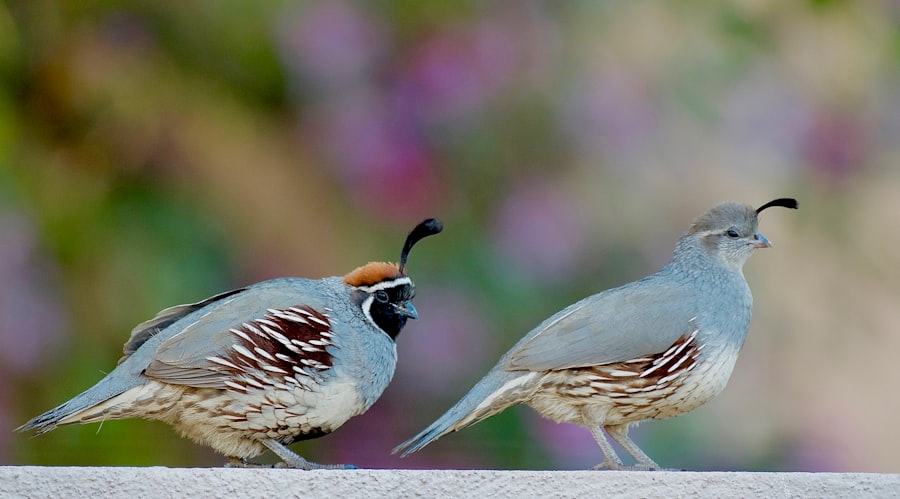Breeding ratios are a critical aspect of managing the population of bobwhite quail. These ratios determine the number of males to females in a breeding group and play a significant role in the overall health and success of the population. By understanding the importance of breeding ratios, quail breeders can ensure the genetic diversity and reproductive success of their birds.
Maintaining proper breeding ratios is essential for genetic diversity within the population. When there are too few males or females in a breeding group, it can lead to inbreeding, which can result in genetic abnormalities and decreased reproductive success. On the other hand, having too many males in a breeding group can lead to increased competition for mates, which can cause stress and lower reproductive success. By carefully managing breeding ratios, breeders can help maintain genetic diversity and ensure the overall health of the population.
Furthermore, breeding ratios also play a crucial role in the reproductive success of bobwhite quail. When the ratio of males to females is optimal, it can lead to increased mating opportunities and higher fertility rates. This, in turn, can result in a larger number of healthy offspring, ultimately contributing to the growth and sustainability of the quail population. Understanding the importance of breeding ratios is essential for breeders to make informed decisions that will positively impact the overall health and success of their quail population.
Table of Contents
- 1 Factors to Consider in Determining Breeding Ratios
- 2 Ideal Breeding Ratios for Bobwhite Quail
- 3 Managing Breeding Ratios for Optimal Results
- 4 Challenges and Considerations in Breeding Ratios
- 5 Monitoring and Adjusting Breeding Ratios
- 6 The Impact of Breeding Ratios on Bobwhite Quail Population
- 7 FAQs
Key Takeaways
- Understanding the importance of breeding ratios is crucial for maintaining a healthy and sustainable population of Bobwhite quail.
- Factors to consider in determining breeding ratios include genetic diversity, population size, and environmental conditions.
- The ideal breeding ratios for Bobwhite quail involve maintaining a balanced male to female ratio to ensure successful reproduction.
- Managing breeding ratios for optimal results requires careful monitoring, selective breeding, and habitat management.
- Challenges and considerations in breeding ratios include predation, disease, and the impact of human activities on quail populations.
- Monitoring and adjusting breeding ratios is essential for adapting to changing environmental conditions and population dynamics.
- In conclusion, breeding ratios have a significant impact on the population of Bobwhite quail and must be carefully managed to ensure their long-term survival.
Factors to Consider in Determining Breeding Ratios
Several factors must be considered when determining breeding ratios for bobwhite quail. These factors include the age and health of the birds, the size of the breeding space, and the overall goals of the breeding program. By carefully considering these factors, breeders can establish optimal breeding ratios that will contribute to the success and sustainability of their quail population.
The age and health of the birds are crucial factors to consider when determining breeding ratios. Older birds may have decreased fertility rates, while younger birds may not have reached sexual maturity. Additionally, the overall health of the birds can impact their ability to successfully reproduce. By considering the age and health of the birds, breeders can ensure that they are selecting optimal breeding pairs that will contribute to the overall success of the population.
The size of the breeding space is another important factor to consider when determining breeding ratios. Overcrowding can lead to increased stress and competition among birds, which can negatively impact their reproductive success. By providing adequate space for breeding groups, breeders can help reduce stress and increase mating opportunities, ultimately leading to higher fertility rates and healthier offspring. Additionally, the size of the breeding space can also impact the ability to monitor and manage breeding groups effectively, making it essential to consider when establishing breeding ratios.
Finally, breeders must consider their overall goals for the breeding program when determining breeding ratios. Whether the goal is to increase genetic diversity, improve specific traits, or maintain a sustainable population, these objectives will influence the selection of breeding pairs and the establishment of optimal breeding ratios. By carefully considering these factors, breeders can establish breeding ratios that align with their goals and contribute to the long-term success of their quail population.
Ideal Breeding Ratios for Bobwhite Quail
The ideal breeding ratios for bobwhite quail typically involve one male for every two to four females. This ratio allows for optimal mating opportunities while minimizing competition and stress among males. Additionally, this ratio helps maintain genetic diversity within the population by ensuring that each male has multiple mates, ultimately contributing to higher fertility rates and healthier offspring.
Maintaining a ratio of one male to two to four females also helps prevent inbreeding within the population. By providing each male with multiple mates, breeders can reduce the risk of genetic abnormalities and maintain a healthy level of genetic diversity. This, in turn, contributes to the overall health and sustainability of the quail population.
Furthermore, establishing an ideal breeding ratio for bobwhite quail involves careful consideration of the size of the breeding space and the overall goals of the breeding program. By providing adequate space for each breeding group and considering specific breeding objectives, breeders can ensure that they are establishing optimal breeding ratios that will contribute to the long-term success of their quail population.
Managing Breeding Ratios for Optimal Results
Managing breeding ratios for bobwhite quail involves careful monitoring and selection of breeding pairs to ensure optimal results. Breeders must regularly assess the health and fertility of their birds, as well as monitor mating behaviors and success rates within each breeding group. By actively managing breeding ratios, breeders can help maintain genetic diversity and reproductive success within their quail population.
Regular assessments of bird health and fertility are essential for managing breeding ratios effectively. Breeders should closely monitor the overall condition of their birds, including their weight, feather quality, and general behavior. Additionally, regular fertility checks can help identify any potential issues that may impact reproductive success. By staying proactive in monitoring bird health and fertility, breeders can make informed decisions about which birds to include in breeding groups and adjust ratios as needed.
Monitoring mating behaviors and success rates within each breeding group is also crucial for managing breeding ratios. Observing mating behaviors can provide valuable insight into which pairs are successfully reproducing and which may need to be adjusted. By closely monitoring mating behaviors and success rates, breeders can identify any potential issues with specific pairs or ratios and make necessary adjustments to ensure optimal reproductive success.
Additionally, managing breeding ratios for optimal results involves careful selection of breeding pairs based on specific traits or objectives. Whether the goal is to improve certain genetic traits or maintain genetic diversity within the population, breeders must carefully consider which pairs to include in their breeding groups. By actively managing breeding ratios through regular assessments and careful selection of breeding pairs, breeders can help ensure the overall health and success of their quail population.
Challenges and Considerations in Breeding Ratios
Breeding ratios for bobwhite quail come with several challenges and considerations that breeders must navigate to ensure optimal results. One challenge is maintaining genetic diversity within the population while also achieving specific breeding objectives. Additionally, managing breeding ratios in a way that minimizes stress and competition among birds can be challenging, especially in limited breeding spaces. By carefully considering these challenges and implementing effective strategies, breeders can overcome these obstacles and establish successful breeding ratios for their quail population.
Maintaining genetic diversity within the population while also achieving specific breeding objectives can be a challenging balance to strike. Breeders must carefully consider which traits they want to improve or maintain within their quail population while also ensuring that they are not sacrificing genetic diversity. By implementing strategic breeding pair selections and regularly assessing the overall genetic makeup of their population, breeders can work towards achieving both genetic diversity and specific breeding objectives.
Managing breeding ratios in a way that minimizes stress and competition among birds is another consideration for breeders. Limited breeding spaces can lead to increased stress and competition among birds, which can negatively impact reproductive success. By providing adequate space for each breeding group and closely monitoring bird behavior, breeders can help minimize stress and competition, ultimately contributing to higher fertility rates and healthier offspring.
Additionally, breeders must also consider potential challenges related to maintaining optimal male-to-female ratios within their breeding groups. Factors such as male aggression or decreased fertility rates can impact these ratios and require careful management to ensure reproductive success. By actively addressing these challenges through regular monitoring and strategic pair selections, breeders can overcome these obstacles and establish successful breeding ratios for their quail population.
Monitoring and Adjusting Breeding Ratios

Monitoring and adjusting breeding ratios for bobwhite quail is an ongoing process that requires careful observation and proactive management. Breeders must regularly assess the health and behavior of their birds, as well as monitor mating behaviors and success rates within each breeding group. By actively monitoring breeding ratios and making necessary adjustments based on these observations, breeders can help maintain genetic diversity and reproductive success within their quail population.
Regular assessments of bird health and behavior are essential for monitoring and adjusting breeding ratios effectively. Breeders should closely monitor factors such as weight, feather quality, and general behavior to identify any potential issues that may impact reproductive success. Additionally, observing mating behaviors can provide valuable insight into which pairs are successfully reproducing and which may need adjustments. By staying proactive in monitoring bird health and behavior, breeders can make informed decisions about when to adjust breeding ratios based on specific observations.
Making necessary adjustments to breeding ratios based on observations is crucial for maintaining genetic diversity and reproductive success within the population. If certain pairs are not successfully reproducing or if there are signs of stress or competition within a breeding group, breeders may need to make adjustments to male-to-female ratios or select different pairs altogether. By actively addressing these observations through strategic adjustments to breeding ratios, breeders can help ensure optimal reproductive success within their quail population.
Additionally, monitoring and adjusting breeding ratios also involves careful consideration of specific breeding objectives or traits that breeders may want to improve or maintain within their population. By regularly assessing these objectives alongside observations of bird health and behavior, breeders can make informed decisions about when and how to adjust breeding ratios to align with their overall goals for their quail population.
The Impact of Breeding Ratios on Bobwhite Quail Population
In conclusion, understanding the importance of breeding ratios is essential for maintaining a healthy and successful bobwhite quail population. By carefully considering factors such as age, health, space limitations, and overall breeding objectives, breeders can establish ideal breeding ratios that contribute to genetic diversity and reproductive success within their population. Managing these ratios through regular monitoring and strategic adjustments is crucial for overcoming challenges related to maintaining genetic diversity while also achieving specific breeding objectives. Ultimately, by actively managing breeding ratios based on careful observation and proactive management, breeders can help ensure the long-term health and sustainability of their bobwhite quail population.
If you’re interested in learning more about the breeding ratio for bobwhite quail, you may also want to check out this informative article on duck mating season. Understanding the mating behaviors and ratios for different poultry species can provide valuable insights for successful breeding and raising practices.
FAQs
What is the ideal breeding ratio for bobwhite quail?
The ideal breeding ratio for bobwhite quail is one male to every three to five females. This ratio helps to ensure successful breeding and a healthy population.
Why is the breeding ratio important for bobwhite quail?
The breeding ratio is important for bobwhite quail because it helps to maintain genetic diversity, reduce aggression among males, and increase the likelihood of successful breeding and hatching of eggs.
What happens if the breeding ratio is not balanced for bobwhite quail?
If the breeding ratio is not balanced for bobwhite quail, there may be increased aggression among males, lower fertility rates, and a higher likelihood of infertile eggs. This can lead to a decline in the population and overall health of the quail.
How can I ensure the proper breeding ratio for bobwhite quail?
To ensure the proper breeding ratio for bobwhite quail, it is important to carefully monitor the number of males and females in the breeding environment and make adjustments as needed to maintain the ideal ratio. Additionally, providing adequate space and resources for the quail can help reduce aggression and promote successful breeding.
Meet Walter, the feathered-friend fanatic of Florida! Nestled in the sunshine state, Walter struts through life with his feathered companions, clucking his way to happiness. With a coop that’s fancier than a five-star hotel, he’s the Don Juan of the chicken world. When he’s not teaching his hens to do the cha-cha, you’ll find him in a heated debate with his prized rooster, Sir Clucks-a-Lot. Walter’s poultry passion is no yolk; he’s the sunny-side-up guy you never knew you needed in your flock of friends!







